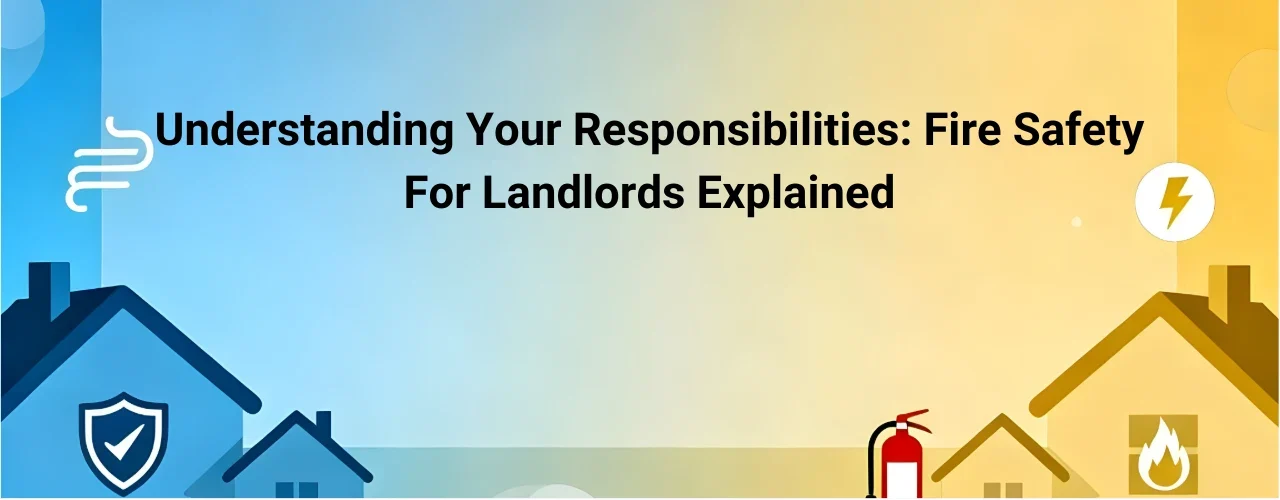
Fire Safety for Landlords: A Comprehensive Guide to Protecting Your Property
Fire safety for landlords carries serious importance in society. In England, among 600, 185 incidents attended by FRSs in 2024, there were 136,702 fires -a decrease of 3.9% compared with the previous year (142,312). Such reduction of fire disaster could happen only due to the serious practice of fire safety regulations and responsibilities. Therefore as a responsible landlord, it’s your responsibility to understand the essential fire safety rules and regulations in order to fulfil them accordingly. It’s your responsibility to ensure the well-being of your tenants and protect their investments.
This blog will provide you with comprehensive fire safety guidance which is specifically tailored for landlords in London. You will learn legal obligations and best practices for ensuring fire safety in the rental properties, HMOs, care home, etc,. along with other essential relevant subjects. Keep reading to learn and implement necessary safety measures.
- What Are the Fire Safety Regulations for Landlords?
- What Is a Fire Safety Certificate for Landlords?
- What Are the Landlord’s Responsibilities for Fire Safety?
- What Safety Checks Should Landlords Conduct?
- How to Conduct a Fire Risk Assessment as a Landlord?
- How can landlords ensure fire safety in rented properties?
- What fire safety measures are essential for care homes?
- What are the implications of fire safety for HMO properties?
- What Are the Fire Safety Requirements for Rented Properties?
- What Is the Role of Fire Alarms in Fire Safety?
- How to Implement Emergency Lighting in Properties?
- What Are the Best Practices for Fire Extinguishers?
- What Are the Fire Door Regulations for Landlords?
- How Can Landlords Ensure Gas and Electrical Safety?
Table of Content
What Are the Fire Safety Regulations for Landlords?
Landlords have a legal duty to prevent fires and protect tenants by providing a safe living environment, which includes several regulations. And all the regulations regarding fire safety for landlords are aimed to minimize the life risk that can cause from fire in rental properties.
What are the key fire safety regulations landlords need to know?
Landlords have a legal duty to prevent fires and protect tenants by providing a safe living environment, which includes several regulations. And all the regulations regarding fire safety for landlords are aimed to minimize the life risk that can cause from fire in rental properties.

Smoke Alarms
The first key regulation involves smoke alarms. Landlords must install at least one working smoke alarm on every floor of a rental property that is used as living accommodation. These alarms must be tested and confirmed to be in working order at the start of each new tenancy. Smoke alarms are crucial for early detection of fires and for protecting tenant safety.

Carbon Monoxide Alarms
Landlords are legally required to install a carbon monoxide alarm in any room used as living accommodation where there is a solid fuel-burning appliance (such as a wood-burning stove or coal fire). From October 2022, this requirement also applies to gas appliances, excluding gas cookers. Carbon monoxide is a lethal gas produced when fuel burns incompletely, making proper detection vital.

Gas Safety
Under the Gas Safety (Installation and Use) Regulations 1998, landlords must arrange an annual gas safety check by a Gas Safe registered engineer for all gas appliances, fittings, and flues. A copy of the Gas Safety Certificate (CP12) must be provided to existing tenants within 28 days of the check, and to new tenants before they move in.

Electrical Safety
Landlords must comply with the Electrical Safety Standards in the Private Rented Sector (England) Regulations 2020, which require that electrical installations in rental properties be inspected and tested at least every five years by a qualified person. A copy of the Electrical Installation Condition Report (EICR) must be provided to tenants and retained for future reference. Faulty or unsafe electrical systems pose a significant fire risk.
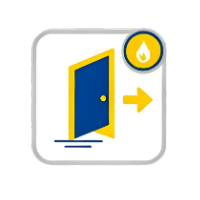
Escape Routes
UK fire safety regulations require that all rental properties have safe, accessible, and clearly marked escape routes in the event of a fire. These routes must be kept clear and maintained in good condition at all times. Even with preventative measures in place, fires can still occur, so having an effective evacuation route is essential for tenant safety.

HMOs (Houses in Multiple Occupation)
- Carrying out a fire risk assessment
- Installing and maintaining fire doors and emergency lighting
- Keeping escape routes clear and fire-resistant
- Providing fire extinguishers and alarms where required
- Supplying tenants with fire safety instructions
These requirements are enforced under the Housing Act 2004 and relevant HMO licensing conditions.
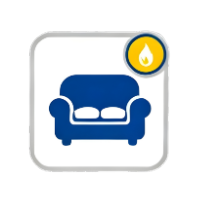
Furniture and furnishings
Furniture and furnishings are also part of fire safety regulations for landlords. Yes, to ensure maximum safety, all supplied items have to meet fire-resistant standards.

Ongoing Maintenance
Ongoing maintenance is another key fire safety regulation for landlords. As a landlord, you have to run regular checks and prompt repairs. It’s highly important to be compliant and ensure the safety of tenants.
How do local authorities enforce fire safety regulations?
Now, let’s have a quick glance of how local authorities enforce fire safety regulations:
Property inspections
Run checks to see if fire safety rules are being followed, especially in rental homes and HMOs.
Risk assessments
Carry out evaluations for potential dangers such as broken alarms and wiring, blocked escape routes, etc.
Licensing schemes
Implement HMO and landlord licenses to ensure that fire safety regulations are consistently followed by the landlords.
Improvement notices
Provide improvement notices when risks/dangers are detected. And landlords have to resolve issues within a specific timeframe.
Prohibition orders
If a property is risky/unsafe, then limit or prohibit people from its entire use.
Legal actions
Impose legal actions, charge fines for noncompliant landlords.
Emergency action
If landlords ignore severe issues, take emergency action. Step in to secure the premises or seize possession.
Local authorities play a vital role in implementing fire safety standards. They run checks and assess risks, especially in HMOs. Also, they may use licensing systems to make sure every landlord follows the fire safety regulations. Authorities will provide improvement notices, or even prohibition orders to stop people from using property in an unsafe way if they discover dangers.
What are the consequences of non-compliance with fire safety regulations?
The consequences of noncompliance with fire safety regulations can be quite serious. For example, not following the rules can lead to big fines, criminal penalties, or even losing your landlord license. Additionally, in extreme circumstances, local councils can take over buildings that are too dangerous to live in, prioritizing tenant safety first.
What Is a Fire Safety Certificate for Landlords?
Moving on to the next essential topic. Here, we will learn about fire safety certificate for landlords.
What does a fire safety certificate signify for landlords?
Every landlord needs to keep their tenants and others safe from fire. In the UK, landlords don’t need a special “Fire Safety Certificate” for normal rental homes. But Landlords must ensure the home is safe from fire. Here are the key things it covers for landlords:
- Confirms fire exits are clear and easy to use.
- Shows smoke alarms and fire alarms work right.
- Proves fire doors are in place and close properly.
- Lists fire risks and how they are controlled.
- Needed for HMOs or large rental buildings.
- Helps protect tenants and property.
- Checks escape routes and lighting work well.
- Makes sure fire equipment is easy to reach.
- Stops trouble with local council or fines.
- Gives peace of mind to both landlord and tenant.
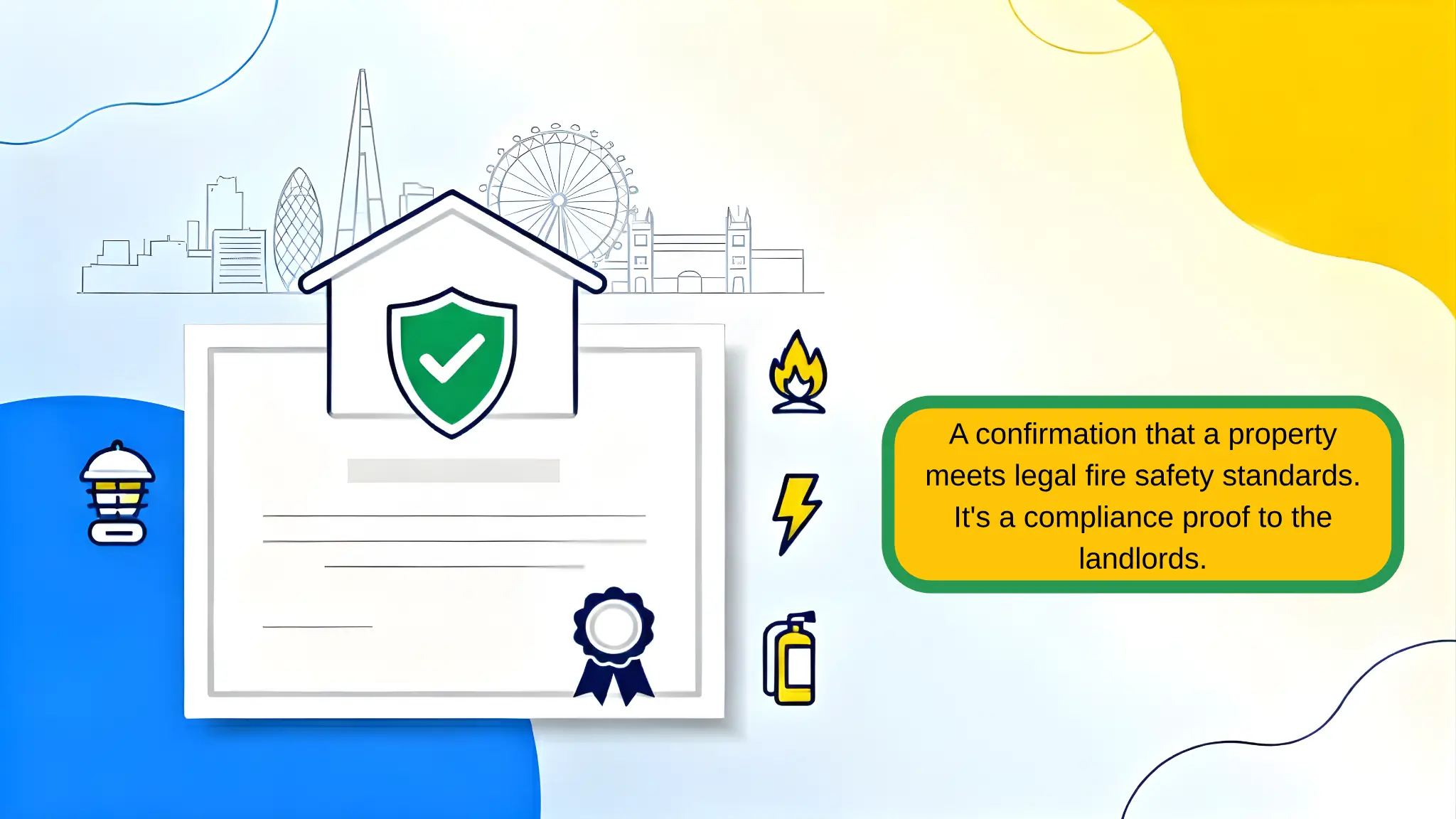
How can landlords obtain a fire safety certificate?
Landlords can obtain a fire safety certificate by:
- Hiring a qualified assessor or from a safety certificates service
- Fire risk assessment
- Review of compliance
- Implement recommendations
- Re-inspection if needed
- Certificate issued
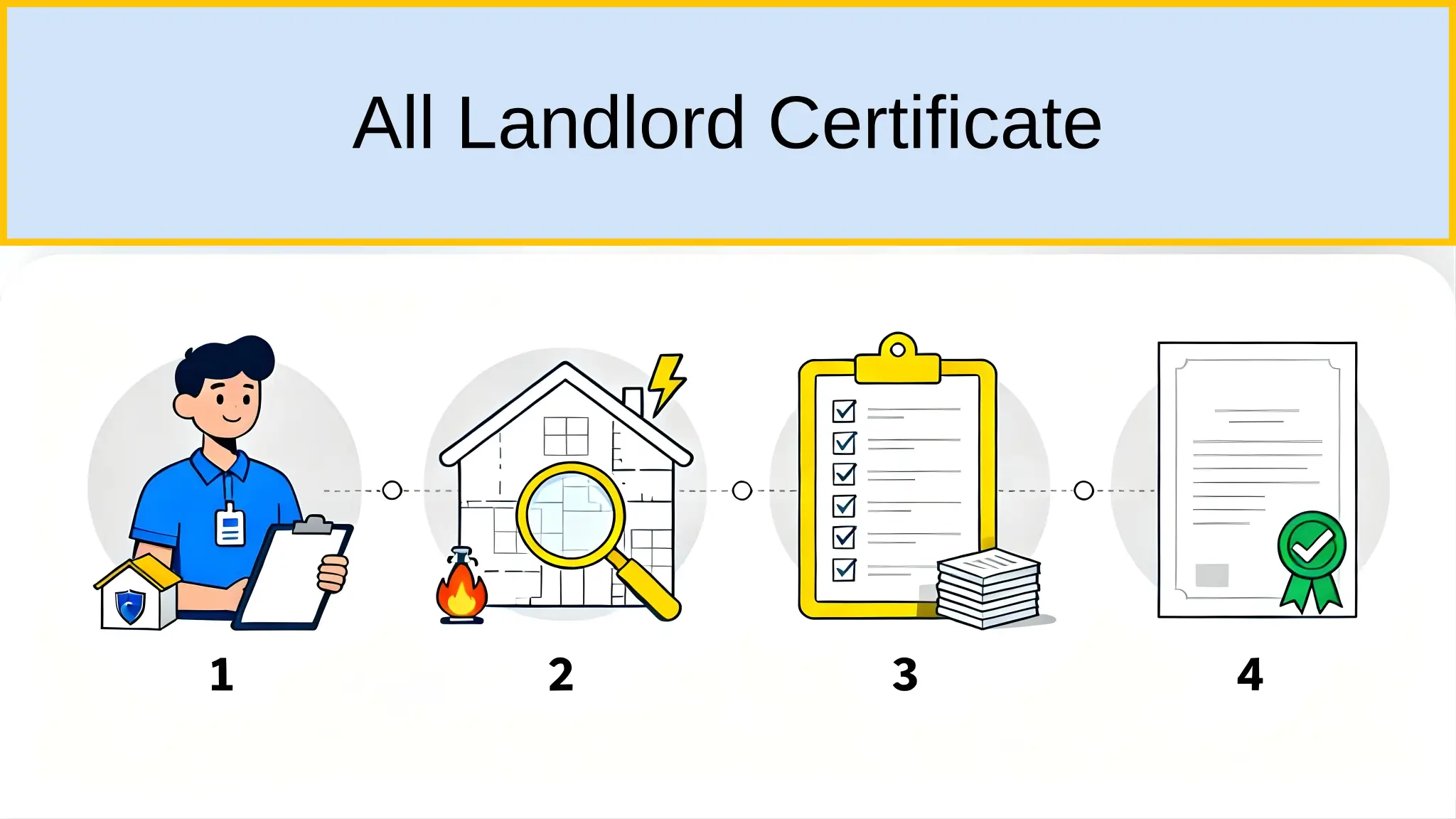
Trained fire safety officers, approved assessors or from a safety certificate service like All Landlord Certificates can provide fire safety certificate for landlords by running a fire risk assessment for landlords. Firstly, the inspector looks at the property to make sure it follows fire safety rules. They check the alarms, escape routes, and safety gear. Finally, the certificate will be given after meeting all the requirements.
What are the renewal requirements for a fire safety certificate?
Landlords don’t need to renew their fire safety certificate. However, they need to make sure that essential fire safety measures are checked and updated on a regular basis.
These include:
- an annual fire risk assessment (or after property changes)
- annual checks and maintenance of smoke
- Carbon monoxide alarms
- annual Gas Safety checks
- and 5-yearly Electrical Installation Condition Reports (EICRs), along with reports updated for new tenancies.
What Are the Landlord’s Responsibilities for Fire Safety?
Landlords have certain responsibilities to assure fire safety. Let’s learn about the landlord’s responsibilities for fire safety.
What specific fire safety responsibilities do landlords have?
- Installing alarms for smoke and carbon monoxide wherever necessary.
- Providing safe and easily accessible escape routes.
- Maintaining fire doors and extinguishers in buildings.
- Ensuring all electrical and gas systems are safe in the property.
- Running regular safety checks or inspections and risk assessments.
- Obeying all local fire safety regulations.
How can landlords ensure their properties meet fire safety standards?
Landlords can ensure their properties are meeting fire safety standards by fulfilling their above mentioned responsibilities. And for that they have to:
- Fit smoke and carbon monoxide detectors in required areas.
- Keep fire extinguishers, alarms, and fire doors in good working order.
- Regularly review fire hazards and update safety measures.
- Keep exits clear, well-lit, and accessible.
- Arrange annual inspections and required certifications.
- Inform tenants about fire safety procedures and emergency contacts.
- Remember to keep records: documents of inspections, maintenance, and compliance for legal protection.
What role do tenants play in fire safety responsibilities?
Well, tenants also have certain responsibility for fire safety. What are those? Let’s learn.
First, tenants should test smoke and carbon monoxide detectors regularly and report faults.
They have to use appliances safely. Like avoiding overloading sockets and following safety guidelines. They need to keep exits clear and accessible. Do not block escape routes or tamper with fire doors. Plus, report hazards/danger issues. Most importantly, they need to inform landlords promptly about faulty wiring, alarms, or equipment. Tenants have to seriously follow essential safety rules. Tenants have to maintain fire safety procedures of the building and act accordingly to evacuation plans. Finally, they should avoid risks. They need to use candles, heaters, and smoking materials with caution and responsibly.
What Safety Checks Should Landlords Conduct?
Now, we will learn about safety checks for landlords that should be conducted with seriousness.
What regular safety checks should landlords perform?
Landlords need to opt for regular safety checks for:
- fire alarms
- extinguishers
- emergency lighting
- fire doors
- escape routes
- electrical systems
- gas appliances
How often should fire risk assessments be conducted?
Fire risk assessments need to be kept up to date and reviewed regularly by qualified professionals. Why? Because routine inspections help identify hazards early and make sure that safety standards are consistently maintained. Also, it has to be updated every 3–5 years, or sooner if the property layout, occupancy, or fire risks change. This is how it will ensure the Fire Safety Order compliance and keep all the safety measures effective and up to date.
What checks are required for smoke and carbon monoxide alarms?
Checks required for smoke and Carbon monoxide alarms:
- Landlords have to install fire alarms on each floor and test them at the start of a new tenancy.
- Make the tenants aware to run checks for alarms regularly.
- Check to ensure that Carbon monoxide alarms are installed in rooms with solid fuel or gas appliances.
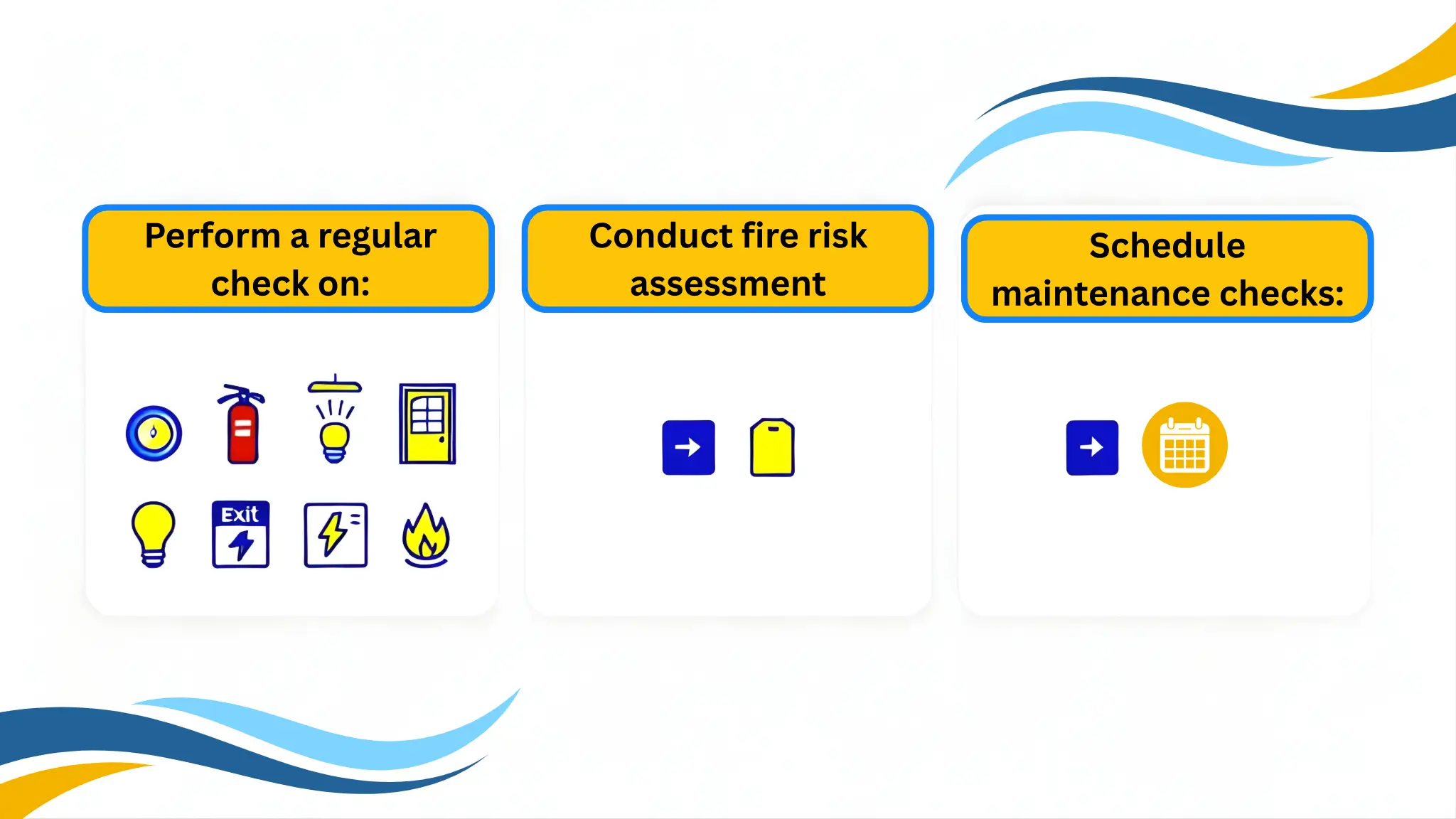
How to Conduct a Fire Risk Assessment as a Landlord?
In this part, let’s go on about conducting a fire risk assessment as a landlord.
What is a fire risk assessment and why is it necessary?
A fire risk assessment is a detailed inspection that identifies potential fire hazards, along with evaluates risks to occupants, and makes plans to reduce them.
Fire risk assessment is essential because:
- To legally required for rental properties
- For ensuring tenant safety
- To remain compliance with regulations
- reducing the risk of costly incidents
What steps should landlords follow to conduct an effective assessment?
Steps that landlords should follow to conduct an effective assessment are:
- Detecting fire hazards; check appliances, wiring, flammable materials, etc.
- Determining who is at risk; tenants, visitors, vulnerable groups.
- Evaluating existing safety measures and highlighting improvements.
- Installing and maintaining alarms, fire doors, and extinguishers.
- Recording findings and implementing changes.
- Reviewing and updating regularly.
How often should fire risk assessments be updated?
Well, fire risk assessments should be updated every 3 to 5 years. You should update fire risk assessment sooner if there are major changes to the property, occupancy, or identified fire risks. It’s essential because regular fire assessment updates ensure that safety measures remain effective and legally compliant.
What fire detection systems should landlords install?
The fire detection systems landlords should install are:
- Smoke alarms on each storey of the property
- Carbon monoxide alarms in rooms with gas appliances or solid fuel burners
- Interlinked smoke or heat detectors and, in some HMOs, a full fire alarm system that meets BS 5839 standards.
Keep in mind that alarms need to be tested at the start of each tenancy.
How do landlords comply with fire door regulations?
Landlords comply with fire door regulations by:
- Installing certified FD30 fire doors (30-minute resistance) in HMOs, flats, kitchen, high-risk rooms and shared properties wherever required.
- Fire doors must be fitted with self-closing devices, kept free from obstruction
- Regular inspection, proper maintenance of doors to comply with the fire safety laws.
How can landlords ensure fire safety in rented properties?
Let’s go over how landlords can ensure fire safety in rented properties.
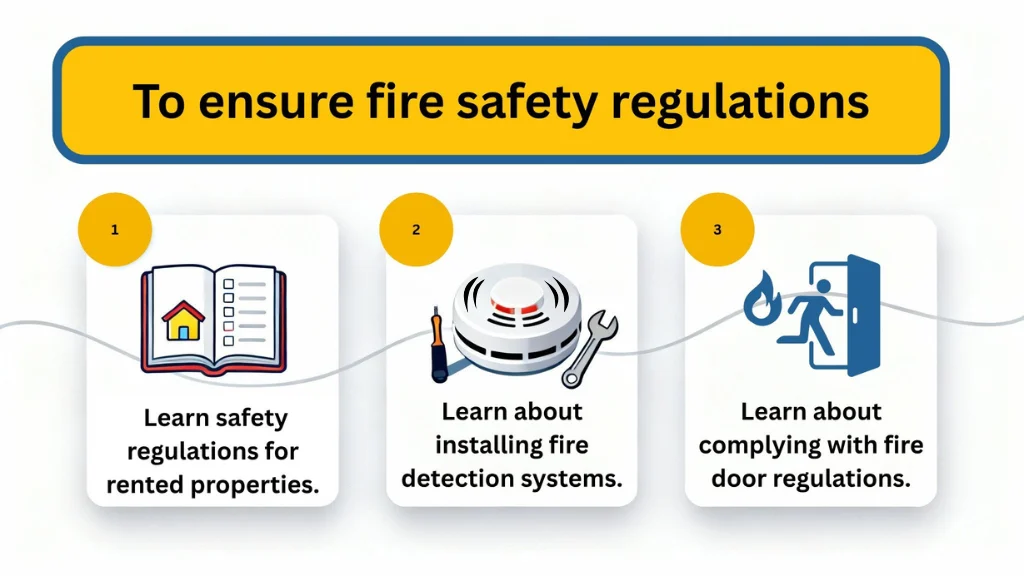
What are the fire safety regulations for rented properties?
Landlords must follow the Regulatory Reform (Fire Safety) Order 2005 . This includes:
- Smoke and Carbon Monoxide Alarm (Amendment) Regulations 2022
- Housing Act 2004
As per these regulations in rented properties landlords must provide smoke alarms on every floor. Additionally, carbon monoxide alarms in rooms with fuel-burning appliances along with safe escape routes, fire doors in HMOs, and regular fire risk assessments.
What fire safety measures are essential for care homes?
Now, let’s go over the essential fire safety for care homes.
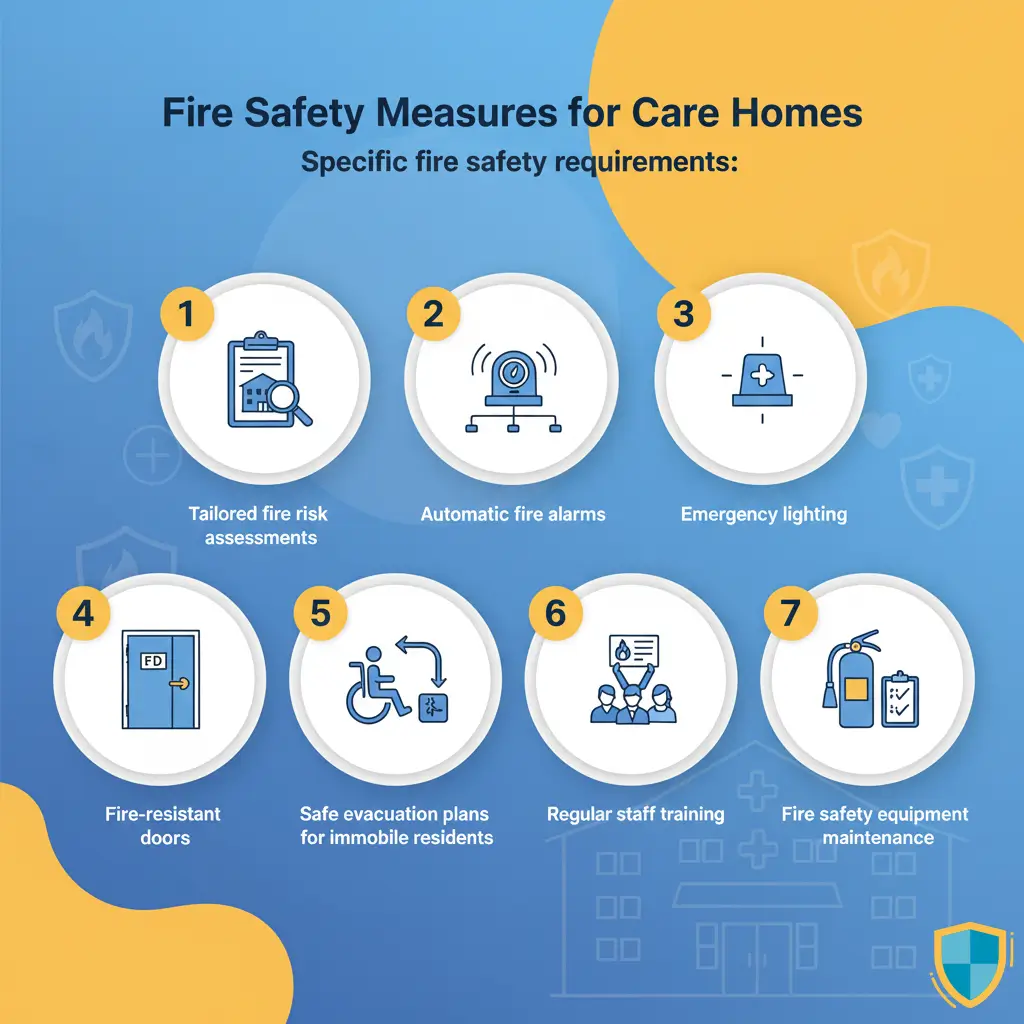
What specific fire safety requirements apply to care homes?
Care homes need to comply with the Fire Safety Order 2005 and Care Quality Commission (CQC) standards.
This includes some specific fire safety requirements:
- tailored fire risk assessments
- automatic fire alarms
- emergency lighting
- fire-resistant doors
- safe evacuation plans for immobile residents
- regular staff training
- maintenance of all fire safety equipment
How can care homes implement effective emergency lighting?
Emergency lighting in care homes should comply with BS 5266 standards. Emergency lights should be installed in corridors, stairwells, and exits, with regular monthly function tests and annual full-duration tests. Also, lighting should provide enough brightness to guide residents safely, especially those with visual or mobility impairments.
What role do fire alarms play in care home safety?
Fire alarms play a vital role in care home safety. Such as fire alarms are critical for:
- Early detection of hazards
- Alerting staff to evacuate vulnerable residents quickly
Systems should be regularly tested, zoned for quick location of fires, and maintained to ensure reliability in emergencies.
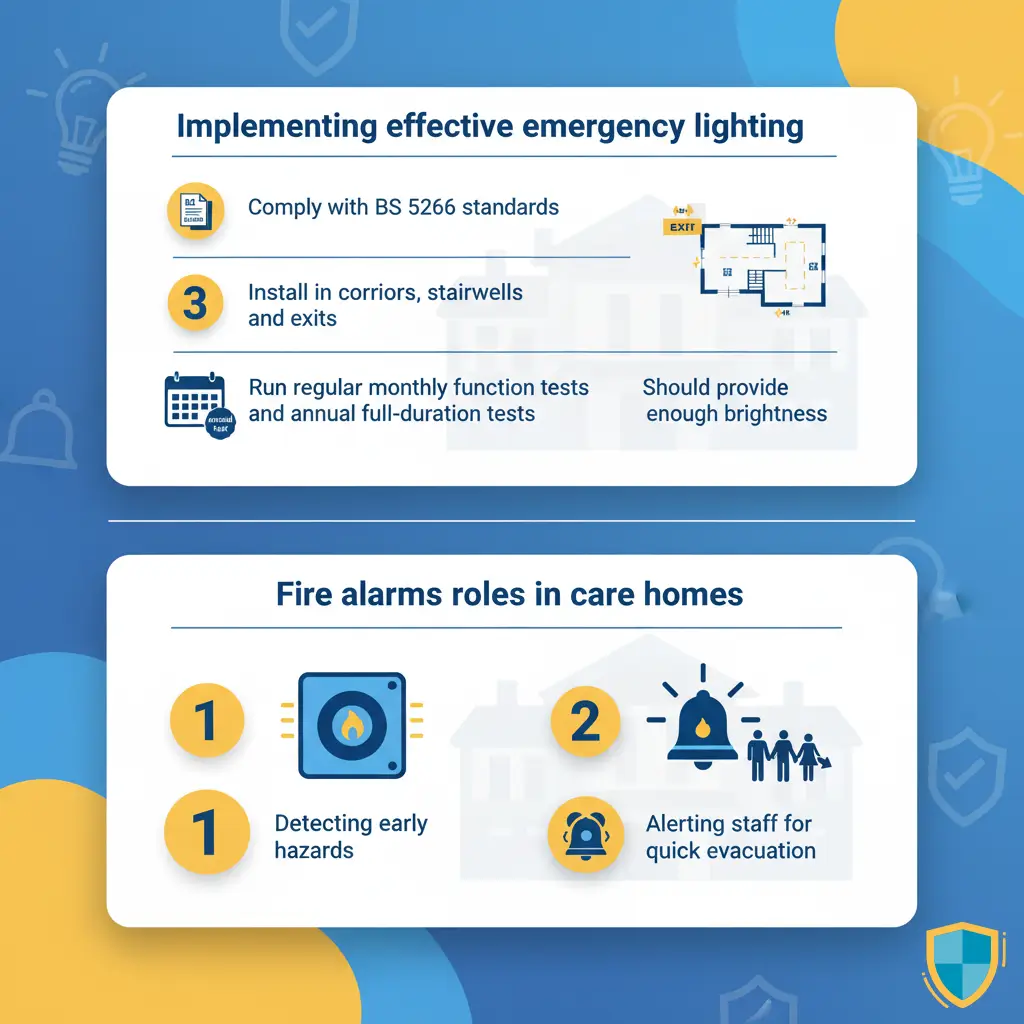
What are the implications of fire safety for HMO properties?
In this section we will go on about the implications of fire safety for HMO properties.
What additional fire safety responsibilities do landlords of HMOs have?
Landlords of Houses in Multiple Occupation (HMOs) have additional legal duties under the Housing Act 2004, the Management of Houses in Multiple Occupation (England) Regulations, and the Regulatory Reform (Fire Safety) Order 2005. Their fire safety responsibilities typically include:
- Installing fire doors with self-closing devices on all rooms opening onto escape routes.
- Providing emergency lighting along all escape routes to ensure visibility during power failure.
- Ensuring escape routes are protected by fire-resistant construction, typically providing at least 30 minutes of fire resistance.
- Installing and maintaining appropriate fire detection and alarm systems, often a Grade A LD2 system in larger HMOs.
- Keeping communal areas clear of obstructions and fire hazards at all times.
- Displaying clear and accessible fire safety instructions, including evacuation procedures and emergency contact information.
- Providing firefighting equipment (e.g. extinguishers, fire blankets) where required by the fire risk assessment.
- Carrying out regular and documented fire risk assessments, updated when occupancy or layout changes.
- Appointing a Responsible Person (usually the landlord or managing agent) who is legally responsible for fire safety compliance in shared areas.
What is the role of local authorities in HMO fire safety compliance?
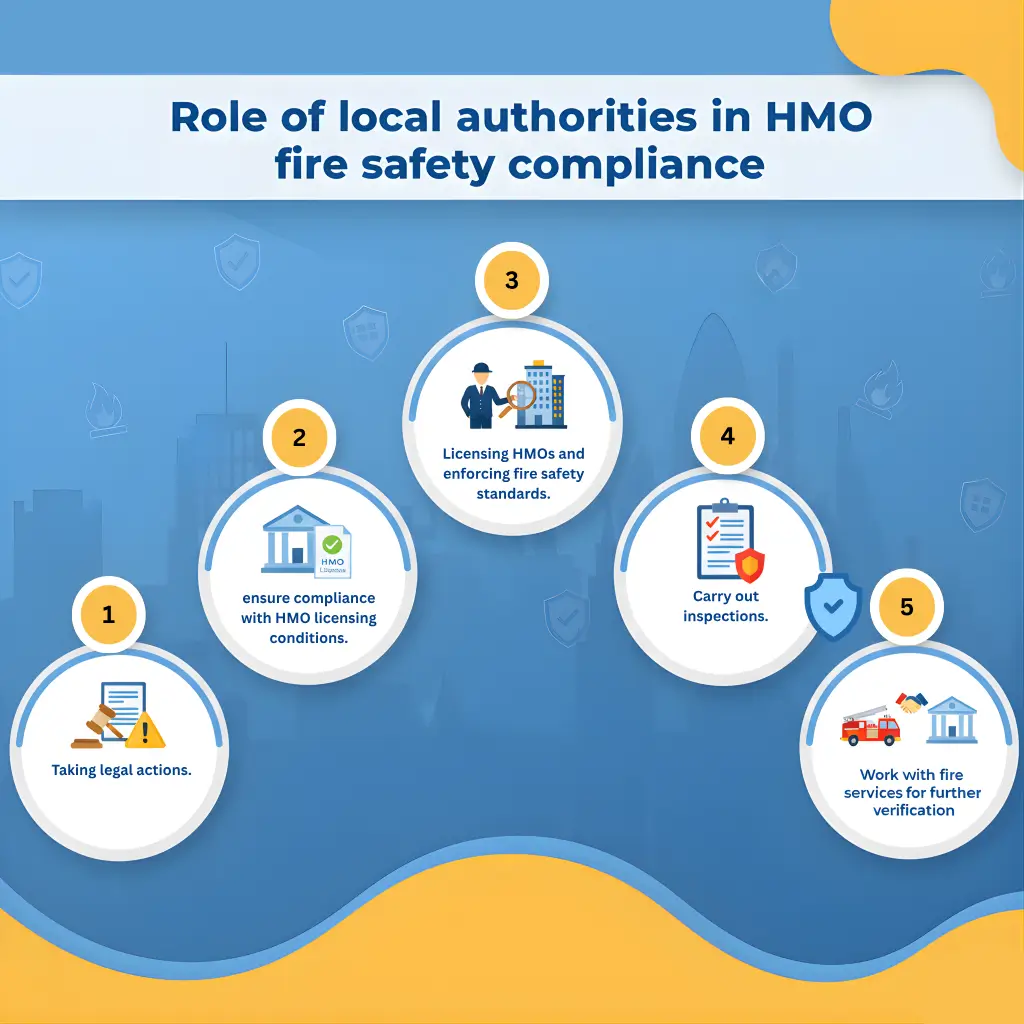
The local authorities play a vital role in HMO fire safety compliance. For example, local authorities play a role in licensing HMOs and enforcing fire safety standards. Additionally, the local authorities carry out inspections, and ensure compliance with HMO licensing conditions. They can take legal actions like issuing fines or prohibition notices for unsafe properties. Plus, councils work with fire services to verify landlords are fulfilling their responsibilities, meeting their obligations and protecting tenant safety.
How can landlords effectively manage safety in blocks of flats?
The fire detection systems landlords should install are:
- Carrying out block-wide fire risk assessments on a regular basis
- Maintaining common areas properly
- Installing fire alarms wherever required
- Ensuring fire doors are in place
- Always keeping escape and emergency routes clear
Apart from these the landlords need to comply with the Fire Safety Act 2021, which adds responsibilities to external walls and cladding. Also, regular maintenance and tenant communication are essential and key in effectively managing safety in blocks of flats.
What Are the Fire Safety Requirements for Rented Properties?
Now, we will go over the subject of fire safety for rented properties.
What Fire Safety Regulations Must Be Followed?
First, let’s briefly discuss the fire safety regulations that need to be followed by the landlords.
Landlords need to comply with:
- The Regulatory Reform (Fire Safety) Order 2005
- The Housing Act 2004
- The Smoke and Carbon Monoxide Alarm Regulations 2022
According to these regulations, the requirements are: installing alarms, maintaining safe escape routes, and providing fire doors in HMOs. Along with conducting fire risk assessments regularly, and ensuring gas and electrical safety checks properly.
What Fire Detection Systems Are Necessary for Rented Properties?
According to UK law rented properties require:
smoke alarms on every floor and carbon monoxide alarms in rooms with fuel-burning appliances. Additionally, HMOs should have interlinked smoke and heat detectors. Plus, larger and higher-risk properties may need full alarm systems meeting BS 5839 standard. Meaning, fire alarms that are professionally designed and installed fire alarm systems that have control panels, zoned detection, and automatic and manual call points for quick identification and evacuation.
How to conduct a Fire Risk Assessment for your property?
To conduct a fire risk assessment for your property as a landlord you need to:
Detect possible fire hazards
check for faulty wiring, heating appliances, smoking areas, and flammable materials.
Assess who is/are at risk
consider tenants, visitors, and vulnerable individuals like elderly and disabled persons.
Evaluate existing precautions
evaluate the precautions and implement them accordingly. For example, inspect all the alarms, fire doors, extinguishers, and escape routes.
Implement improvements
install or upgrade detection systems, emergency lighting where needed.
Record and act
findings have to be recorded and acted upon. Don’t forget to keep written evidence of risks, actions taken, and responsibilities.
Review regularly
update at least yearly or when property changes occur.
What Is the Role of Fire Alarms in Fire Safety?
Here we will go over the role of fire alarms in fire safety.
How Can Landlords Ensure Fire Alarms Are Functional?
Landlords can ensure fire alarms are functional by:
- Testing fire alarms at the start of each tenancy.
- Annually arranging regular maintenance and servicing.
- Encouraging all the tenants to test fire alarms regularly. Preferably weekly.
- Replacing fire alarms’ batteries promptly whenever needed or installing tamper-proof sealed units.
What Are the Requirements for Fire Alarms in HMO Properties?
Requirements for fire alarms in HMO properties:
- Interlinked smoke alarms should be in hallways, landings, and living areas.
- Heat alarms should be in kitchens.
- Larger HMOs often require full alarm systems meeting BS 5839 as explained before.
- Alarm systems have to cover escape routes and communal spaces.
- Alarms have to be tested at the start of tenancy and maintained regularly.
How Do Different Types of Fire Alarms Work?
Let’s get to know about 4 different types of fire alarms and how they work.
Lonisation alarms
detect fast-flaming fires through smoke particles.
Optical alarms
sense slow, smouldering fires using infrared light.
Heat alarms
respond to rapid temperature rise, and it’s ideal for kitchens.
Interlinked systems alarms
trigger all alarms when one is activated, ensuring a full coverage.
How to Implement Emergency Lighting in Properties?
Now we will go on about implementing emergency lighting in properties.
What are the regulations surrounding emergency lighting?
In the UK, emergency lighting has to comply with both the Regulatory Reform (Fire Safety) Order 2005 and BS 5266 standards. Emergency lightings:
- Required in HMOs, blocks of flats, and communal/shared escape routes.
- Must illuminate corridors, stairways, and final exits during power failures.
- Regular checks or testing and maintenance are legally required.
According to these regulations, the requirements are: installing alarms, maintaining safe escape routes, and providing fire doors in HMOs. Along with conducting fire risk assessments regularly, and ensuring gas and electrical safety checks properly.
How can emergency lighting enhance tenant safety?
Emergency lighting ensures that escape routes remain visible during power cuts or fires. Emergency lighting helps in reducing panic and assisting tenants evacuate quickly. Not only that, it provides illumination for staircases, corridors, and exit points, especially helps in protecting vulnerable residents. Needless to say, emergency lighting greatly improves overall safety and compliance in rental and shared properties.
What maintenance practices are necessary for emergency lighting?
Maintenance practices for emergency lighting, landlords have to conduct:
A monthly function tests
briefly switch off mains power to check how the emergency lights operate.
An annual full-duration test
ensure backup batteries last properly.
Immediate repairs
fix faults without delay to maintain compliance and reduce risks and hazards.
Record keeping
maintain logs of all inspections and tests. This comes as a solid proof of compliance.
Professional servicing
go for professional servicing for reliability. Arrange periodic checks by qualified electricians.
Review regularly
update at least yearly or when property changes occur.
What Are the Best Practices for Fire Extinguishers?
This section involves fire extinguishers best practices. Let’s learn!
What Types of Fire Extinguishers Should Landlords Provide?
There are 3 Types of fire extinguishers that landlords should provide:
Water or foam extinguishers
It’s for solid materials such as wood, paper, textiles.
CO₂ extinguishers
This is for electrical fires and flammable liquids.
Dry powder extinguishers
It’s versatile but not ideal indoors due to residue.
Where Should Fire Extinguishers Be Located in Rented Properties?
How Can Landlords Educate Tenants on Using Fire Extinguishers?
To educate tenants on using fire extinguishers landlords should:
- Provide clear written instructions to the tenants. Even better if instruction posters are kept near extinguishers.
- Explain the PASS method to the tenants. Well, what’s that?
P for –Pulling
Pulling the pin to unlock the extinguisher.
A for –Aiming
Aiming the nozzle at the base of the fire, not the flames.
S for –Squeezing
Squeezing the handle to release the extinguishing agent.
S for –Sweeping
Sweeping the nozzle from side to side, covering the fire base until it is out.
This method ensures tenants can operate extinguishers effectively and safely during small fires.
- Inform the tenants that extinguishers are for small fires only and emphasize on making evacuation a priority.
- In tenant welcome packs, arrange fire safety briefings or include guidance.
- Near high-risk areas such as kitchens and boiler rooms.
- In HMOs, keep at least one extinguisher per floor in communal areas.
- Inside the escape routes. Place the fire extinguisher mounted on walls or in visible, accessible spots.
Remember, fire extinguishers’ placement have to comply with fire risk assessment findings and local authority guidance.
What Are the Fire Door Regulations for Landlords?
Now, we will cover the fire door regulations for landlords.
What are the key regulations regarding fire doors?
In the UK, fire doors must comply with:
- Building Regulations Approved Document B and Fire Safety Order 2005
- The fire doors should remain closed when not in use.
- The fire doors should be in between flats, in high-risk rooms, and in escape routes.
- The fire doors should be typically rated FD30 which is for 30-minute resistance or FD60 for 60-minute resistance.
- Fire doors need to have self-closing devices fitted and functional.
- To maintain fire resistance, fire doors should be installed with correct frames, seals, and hardware.
- Regular inspection and maintenance are legally required for fire doors.
- Buildings containing two or more sets of domestic premises that are above 11 metres in height must undertake checks of fire doors at the entrances of each domestic premises in the building at least every 12 months.
How can landlords ensure their properties comply with fire door standards?
Landlords can ensure thor properties comply with fire door standards by:
- Installing certified fire doors
- Checking that self-closing devices work properly in fire doors
- Avoiding wedging doors open
- Maintaining frames and seals of fire doors
- Conducting regular inspections for the fire doors
Apart from these, keeping records of installation and maintenance helps demonstrate compliance with UK fire safety laws.
What are the consequences of failing to meet fire door regulations?
The consequences of failing to meet fire door regulations are quite serious.
Under the fire safety order of 2005, the non-compliance can lead to:
- Fines
- legal action
- Imprisonment
Not meeting fire door regulations increases risk of injury and death during a fire. The consequences can lead to invalidating insurance. And may also result in enforcement notices from local authorities or fire services.
How Can Landlords Ensure Gas and Electrical Safety?
Now all we are left with is gas and electrical safety. So, in this final section, we will discuss how landlords can ensure gas and electrical safety.
What are the gas safety responsibilities for landlords?
For landlords, the first and most essential step in ensuring gas safety is by fulfilling the gas safety responsibilities with utter seriousness. And the gas safety responsibilities for the landlords includes:
- Arranging annual Gas Safety Certificate (CP12, officially called a landlord gas safety record) checks by a Gas Safe registered engineer
- Maintaining all gas appliances, pipes, and flues
- Providing tenants with copies of gas safety records before they move in and within 28 days of annual checks.
- Keep records of gas safety checks at least for 2 years.
- Run an annual gas safety check within 12 months of installing a new appliance or flue.
- Every complications need to be repaired as soon as possible to:
- Prevent carbon monoxide risks
- Ensure compliance with the Gas Safety Regulations 1998
What regulations govern gas and electrical safety in rented properties?
The gas safety is governed by Gas Safety (Installation and Use) Regulations 1998.
- This regulation mandates an annual gas safety check by a gas safe registered engineer.
- Landlords have to provide tenants with a Gas Safety Certificate (CP12) within 28 days of inspection.
The electrical safety is governed by Electrical Safety Standards in the Private Rented Sector (England) Regulations 2020. And according it:
- This regulation seeks electrical inspections every 5 years.
- Qualified electricians have to carry out Electrical Installation Condition Reports (EICRs).
- Landlords have to fix any identified electrical hazards within 28 days or sooner if urgent.
These laws altogether, ensure landlords protect tenants from fire, electrical and health hazards.
How important is electrical safety in fire prevention?
For any landlord, understanding the importance of electrical safety in fire prevention is very essential. Otherwise, you won’t take the matter with serious concern and hence, the possibility of electrical risks can be high.
Therefore, get the fact that electrical faults are a leading cause of fires in UK homes. Running regular checks, keeping safe wiring, and properly maintained appliances reduce risks significantly. Landlords have to ensure electrics are checked by qualified professionals. It’s crucial for preventing overloaded circuits or faulty installations that can otherwise lead to devastating fire incidents.
Wrap Up
It’s time to wrap up! Fire safety for landlords carries serious value in society. And in this blog we have discussed fire safety measures, regulations, responsibilities, an overall guide specifically tailored for landlords. Implement all your fire safety learning to ensure safety to your tenants. Be a responsible landlord and collect your required fire safety certificate from All Landlord Certificates if you haven’t already.
Need Your Fire Safety Certificate Today?
Get Your Fire Safety Certificate from All Landlord Certificates today. Our Qualified Assesors Ensure Your Property Meets All Legal Fire Safety Standard.
Frequently Asked Questions (FAQ) - ALC
Both landlords and tenants have a role. Landlords must check smoke alarms, fire doors, and escape routes. Tenants must keep exits clear, use things safely, and tell landlords about any fire safety problems.
Fire safety knowledge helps keep people safe. It teaches how to stop fires from starting and what to do if a fire happens. It can save lives and protect homes from damage. Landlords and tenants both need to understand fire safety to keep the property safe.
Beyond meeting legal requirements, consider implementing additional safety measures like installing fire doors, providing fire safety training for tenants, and ensuring all electrical and gas appliances are regularly serviced
Regularly check official resources like the Gov.uk or Alllandlordcertificates.co.uk website and consult with local authorities or professional bodies to stay informed about any changes in fire safety laws.
Beyond meeting legal requirements, consider implementing additional safety measures like installing fire doors, providing fire safety training for tenants, and ensuring all electrical and gas appliances are regularly serviced.